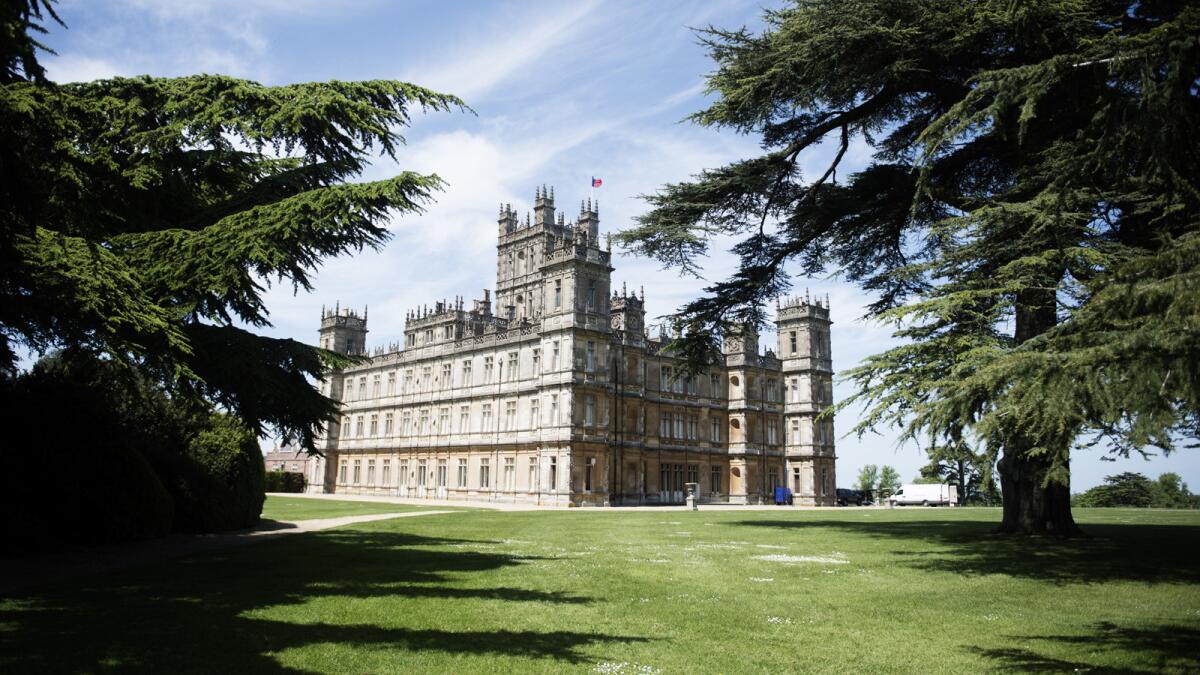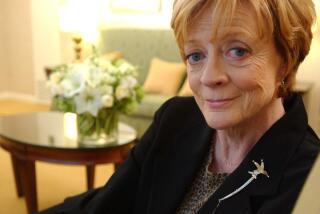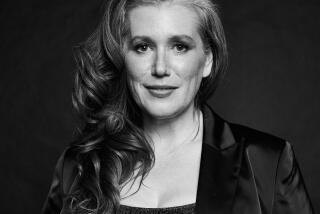Column: ‘Downton Abbey’ movie: Who needs plot or character continuity? Fans just want a dark ride

- Share via
Last night I dreamt I went to Downton again.
Well, actually it wasn’t a dream, it was a movie, a movie much like a dream in that I seemed always to be traveling through a series of overly appointed rooms in which ridiculous things happened and were said by people who seemed familiar and yet not.
Watching this movie that might have been a dream I found myself thinking things like: “Well, that makes no sense.” “God, Maggie Smith must be sick of those hats.” And, “why am I here?” Yet each time I made an attempt to extricate myself, something lovely and comforting would occur — look, it’s Imelda Staunton! — and I would settle in once again, surrendering to the sweet oblivion of dancing women in dazzling dresses, handsome men with faces full of only love, ceilings that rose to exquisite heights, never darkened with the ghosts that so often haunt homes with a hundred watching windows and no soul.
“Downton Abbey” is nothing but soul. It is also a masterclass in the difference between good television writing and good film writing, the first being character-driven and elastic (who knows how long this thing will last?), the other more plot-driven and focused (we’ve only got two hours so kill that darling).
“Downton” illuminates this divide by being neither. It is instead a long, meandering, all but interactive experience for the many fans of the late, lamented PBS series who miss every little thing, from the sweeping lawns leading up to that edifice of golden majesty to the long, glimmering chains that hang just so down the dresses of the Crawley women.
Cynics among us may wonder, why? Why, in this age of cinematic television, and after such debacles as the”Sex and the City” movies, “The X-Files” and (shudder) “The Powerpuff Girls,” why do we keep tacking movies onto the end of perfectly good television shows?
Answer: Because the fans.
Also because “Star Trek,” “Mission: Impossible” and “21 Jump Street.”
But mostly because the fans.
More homage than sequel, “Downton” does not bother itself with the pesky problems of plot (the king and queen are coming is, for the record, not a plot) or character continuity (the Downton serving staff has apparently been replaced by the cast of “Gilligan’s Island”) because it really doesn’t have to. The fans are not there to judge; they just want to know that Lady Mary (Michelle Dockery) is still happy, that the Dowager Countess (Smith) remains acerbic and hilarious, and that neither of the Bateses (Joanne Froggatt and Brendan Coyle) are back in jail.
Julian Fellowes’ “Downton Abbey” movie brings Maggie Smith, Elizabeth McGovern, Michelle Dockery, Hugh Bonneville and company to the big screen.
Trekkies, or Trekkers, have nothing on “Downton Abbey” fans. These are people who rediscovered the pleasures of crustless sandwiches and tipped the at-the-time still-nascent television renaissance to its merchandising possibilities. From pretty much the moment “Downton Abbey” premiered, tiaras and tea sets began flying off the shelves (and websites) while any venue with a garden or a formal dining room was suddenly booking high teas and Downton events.
If anyone questioned why, exactly, Americans were so infatuated with the epitome of a class society, well, let them eat scones — recipes for which were available in innumerable “Downton Abbey” cookbooks. (All of which came in very handy when many of those same viewers fell in love with “The Crown.”)
These fans don’t want to be bothered by complaints that we have never heard of this incredibly important cousin Staunton plays before now, or indignation over Barrow (Robert James-Collier) not being fired on the spot for sassing an earl to his face. They just want to see their beloved Downton again.
Is that so wrong?
Who, after all, wouldn’t want to live in the baronial splendor of a home that enchanted upstairs and downstairs personnel alike? Who doesn’t miss the wide, green lawns and wide-bannistered staircases? The cozy fraternity of the servants’ dinner?
“Downton Abbey” was an international smash hit but bringing the historical soap to the big screen took a massive effort from cast and crew.
It is, of course, possible to visit Highclere Castle, the “actual” Downton (the chance for one lucky couple to spend the night will be made available on Airbnb on Oct. 1 and should break the internet). But to do that, you have to fly to England and even then the Dowager Countess will not be there. No, nor any of the characters who have done more to resurrect a love for the aristocracy since the halcyon days of Princess Diana. To be reunited with them, and the stately home of Julian Fellowes’ imagination, you will need to see the movie, which, we have been repeatedly reminded with something approaching the Dowager’s snobbishness, is showing in theaters only.
This is, in itself, a throwback to a statelier past. Once upon a time, not that very long ago, movies were considered superior to television; a film adaptation of a series was a step up in entertainment society.
Nowadays, it’s a bit more complicated. Television remains ascendant while the box office struggles and there are currently so many films being turned into series that it’s difficult to keep track (fingers crossed, though, for “Galaxy Quest” and “Single White Female”).
Still, “Downton” is not alone in its use of film not as an adaptation but a continuation of their stories. Mere hours before “Downton Abbey” arrived in theaters, Netflix announced that “El Camino: A Breaking Bad Movie” would also get a theatrical release (albeit simultaneous with its streaming premiere) and appears to have “franchise” baked into the title.
“Downton,” however, may be the only series that started as a movie — Robert Altman’s “Gosford Park,” which Fellowes wrote, albeit with a far more dark and scathing vision of his country’s class system — and ended the same way.
But where the world-building of “Gosford Park” rested almost entirely on the characters, Downton Abbey has always been the real star of its eponymous show; its fate may have stood for something larger, but it also remained quite particular to the edifice itself, its architecture and its contents, which included but were not limited to the people who lived there.
Watching it is less like a return to the series, which, like all good television, knew how to parcel out plot, tend character and resist closure whenever it could, and more like a visit to a fully immersive exhibition. Here they all are, once again, the people you love in their wonderful clothes, dishing eggs from the warming trays and chopping carrots in their aprons while they engage in dialogue that assures you they will never change, not really, nor will Downton in all its splendor and drawing room adventure.
If only there had been a few dragons, it could have become a dark ride: “Downton Abbey and the endless fete.”
More to Read
The biggest entertainment stories
Get our big stories about Hollywood, film, television, music, arts, culture and more right in your inbox as soon as they publish.
You may occasionally receive promotional content from the Los Angeles Times.











